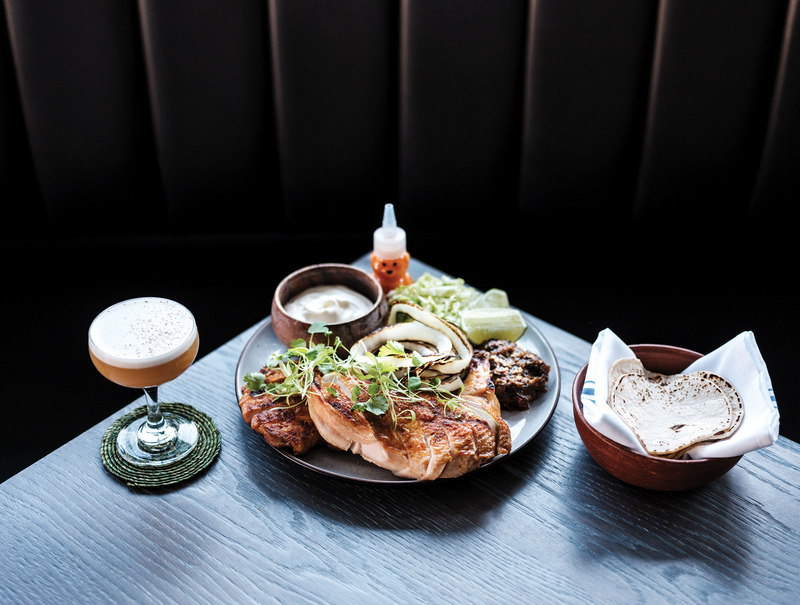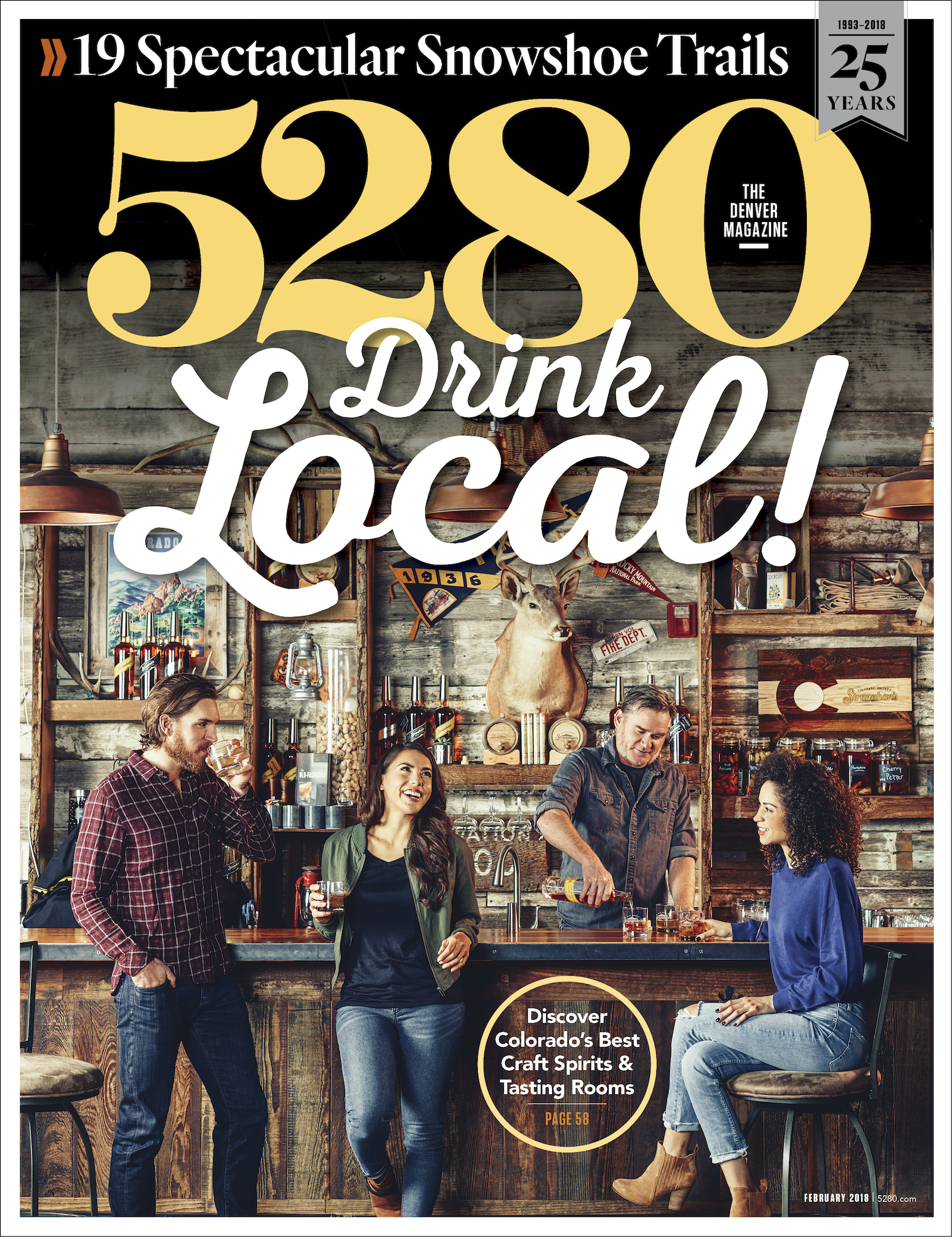The Local newsletter is your free, daily guide to life in Colorado. For locals, by locals.
Señor Bear
3.5 Stars
- The Draw:
- Convivial neighborhood spot for creative, rustic Latin American cooking
- The Drawback:
- A few dishes lose their way in fusion territory
- Don’t Miss:
- Short ribs, mussels, bean stew, mofongo, pig tail, wings, daily congelado cocktail
It’s been ages since I was as surprised by a Denver restaurant as I was recently by Señor Bear. Chalk up my low expectations to its Latin-fusion theme, which can lure lesser kitchens into a culinary uncanny valley—not quite here, not quite anywhere. But partners Juan Padro, Katie O’Shea Padro, Max Mackissock, Kevin Eddy, and Blake Edmunds, the folks behind Señor Bear and Bar Dough (who appear to have a weakness for silly restaurant names), possess a good compass and know where they’re bound.
In the case of Bar Dough, they created a shiny, spirited LoHi restaurant that, at its best, dances past generic Italian fare to achieve real urban brio, in vibe and flavors. Señor Bear, in the space at the corner of 33rd and Tejon streets that was most recently held by Jezebel’s Southern Bistro & Bar (and earlier, the original Squeaky Bean, where Edmunds and Mackissock first worked together), is cozier than its predecessors. With hanging plants, basket-weave pendant shades, wood and gray accents, blue-and-white tile, and south of the border knickknacks, the room is warm, casual, and a bit generic. The focus is mostly on the food—which is fine by me—under executive chef Blake Edmunds.
I like to situate myself immediately inside the door at Señor Bear, at the turn of the long bar where three or four people can hear each other talk while enjoying convivial counter service and watching the ice-work and garnish-bustle of the restaurant’s friendly bartender squad. These drink makers know the menu well and are, along with the rest of the serving staff, reliable guides when choosing what to order.

Talk to them, because the menu manages to be verbose concerning ingredients without always telling you what you’ll actually be eating. The heirloom-bean stew, for example, was described as “yellow eye bean, requesón, egg, cabbage, sofrito, pasilla, garlic, midnight moon, mustard frill.” Midnight moon and mustard frill sound like positions from the Kama Sutra. Why not just say “peppery garlic bean stew with ricotta dumplings and a runny egg”? For that’s what it was, and it was very fine—creamy beans and light dumplings in a rich broth that was neither too thick nor too thin.
That dish exemplified the particularity of Edmunds’ technique as well as his instinct to default to the rustic. In spirit, many dishes are closer to Mexican or Peruvian or Puerto Rican country cooking than that of a Latin-fusion laboratory. Which is not to say authenticity is the goal at Señor Bear. Most dishes are mashups. For example, the mole negro consisted of a dark, raisiny-tart mole ringing chunks of deeply roasted squash. A squash vinaigrette added zing, and a pool of Burrata occupied the middle of the plate. It was a delightful mess. Flavors there (and elsewhere) leaned on citrus or vinegar and a skillful selection of chiles that were as much about fruity, musky flavors as they were about peppery heat (though that heat did come). Acid and spice counterbalance food that is not shy on fat, and the result is comfort cooking with verve and backbone.

Another example of the genre: braised short ribs with “chile verde, hominy, yellow Indian woman beans, squash, shallot, pickled chiles.” Short rib is technically correct but fails to properly describe the off-the-bone meat—substantial but succulent, as if pulled from a long simmer over a wood fire—in a green sauce made tart with tomatillos. It was a bowl to commune with.
With dishes this rich, one might want to drink beer; Señor Bear’s short list hops from Mexico to Germany to Colorado. But the rum- and tequila-based cocktail offerings are clever and held my attention through three dinners. Citrus, usually lime, provides the high notes you want with food like this. Oddities, such as French banana liqueur and pineapple cordial, riff on the tropical theme without getting sugary. I particularly liked the blueberry-infused Das Okay; the Parcha De Mi Vida, a passion-fruit-tinged take on the pisco sour; and the Peruvian Apocalypse, another sour, this one served in a Tiki mug and made faintly spicy with chile verde. The tall drinks are loaded with crunchy fountain ice, and the daily congelado slushies (one night containing passion fruit, ginger beer, and rum) pack a terrific boozy wallop. In other words, you might want to take Lyft rides to and from Señor Bear.
Lively food and drink served by attentive staff make for happy eating, and I had only a few complaints. A weird experiment with stir-fried broccoli, french fries, oyster mushrooms, and chile aïoli, meant for stuffing into chive crêpes, suggested a Chinese chef hallucinating at a Taco Bell. I ordered a plate called Duroc Pork without asking what “salmuera” was, expecting—given precedent—a rugged stew or perhaps a charred chop. Turns out, salmuera is a brine often used in Argentine cooking; despite the deep seasoning a brine promises, the meat on the plate was rather bland, arrayed in slices in a scant orangey sauce.

Still, the menu ranges successfully into raw seafood (scallops were delicious in a cold cucumber chile juice); a salad (arugula, peanuts, and avocado were showered with crunchy fried quinoa and Manchego); and bar snacks (like the confit chicken wings in a tart, fruity glaze). A dish called Crispy Pig Tail delivered crunchy-chewy strips of fried pig ears on top of soft, collagen-loaded knuckles of tail. The meat had a sticky tamarind-onion glaze and was staggeringly unctuous, like postgraduate pork belly. Raw jicama, cabbage, and red onion added vegetable relief, and there were lettuce leaves to wrap it all up.
In the end, what surprised me most at Señor Bear was how surefooted the cooking was, at once loose but exacting. The broth with a bowl of “mofongo” (fried and mashed plantains, pure starchy pleasure) had that lip-coating richness that comes from slowly extracting the essence of bones. Another broth, this one in a bowl of Bangs Island mussels, nodded to cioppino but veered away from fennel in favor of aji chile. We used every bit of the accompanying aïoli-topped ciabatta to sop up the last, spicy drops.

You will even relish the desserts at Señor Bear, which include ever-changing flavors of soft-serve sundaes—micro versions are just $3, though you can get larger portions for $8—and the best plate of piping-hot churros I’ve ever had. The rugged beauties were supremely crunchy outside, tender inside, and served with a decadent “brown butter curd” that was, the night I had it, a silky caramel sauce.
I measure my reaction to a new restaurant by how quickly and vigorously I recommend it to friends. In the case of Señor Bear, that first enthusiastic rec was the morning after my first dinner there. The same after the second, and again following the third. I now give the same advice here: Go to that place with the silly name at the corner of Tejon and 33rd, belly up to the bar, and ask what’s good tonight. They won’t steer you wrong.









